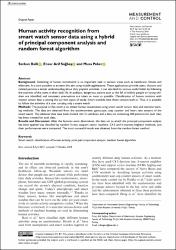| dc.contributor.author | Ballı, Serkan | |
| dc.contributor.author | Sağbaş, Ensar Arif | |
| dc.contributor.author | Peker, Musa | |
| dc.date.accessioned | 2020-11-20T14:43:52Z | |
| dc.date.available | 2020-11-20T14:43:52Z | |
| dc.date.issued | 2019 | |
| dc.identifier.issn | 0020-2940 | |
| dc.identifier.issn | 2051-8730 | |
| dc.identifier.uri | https://doi.org/10.1177/0020294018813692 | |
| dc.identifier.uri | https://hdl.handle.net/20.500.12809/1236 | |
| dc.description | WOS: 000458843900005 | en_US |
| dc.description.abstract | Background: Detecting of human movements is an important task in various areas such as healthcare, fitness and eldercare. It is now possible to achieve this aim using mobile applications. These applications provide users, doctors and related persons a better understanding about daily physical activities. It can also lead to various useful habits by following the activities of the users in their daily life. In addition, dangerous actions such as the fall of elderly people or young children are identified and necessary precautions are taken as soon as possible. Classification of human motions with motion sensor data is among the current topics of study. Smart watches have these sensors built-in. Thus, it is possible to follow the activities of a user carrying only a smart watch. Methods: The purpose of this work is to detect human movements using smart watch sensor data and machine learning methods. The data are obtained from the accelerometer, gyroscope, step counter and heart rate sensors of the smart watch. The obtained data have been divided into 2 s windows and a data set containing 500 patterns for each class has been created for each class. Results and Discussion: After the features were determined, the data set to which the principal component analysis has been applied was classified by random forest, support vector machine, C4.5 and k-nearest neighbor methods, and their performances were compared. The most successful result was obtained from the random forest method. | en_US |
| dc.description.sponsorship | Mugla Sitki Kocman University Scientific Research ProjectsMugla Sitki Kocman University [016-061] | en_US |
| dc.description.sponsorship | This study is supported by Mugla Sitki Kocman University Scientific Research Projects under the grant number 016-061. | en_US |
| dc.item-language.iso | eng | en_US |
| dc.publisher | Sage Publications Ltd | en_US |
| dc.item-rights | info:eu-repo/semantics/openAccess | en_US |
| dc.subject | Smart Watch | en_US |
| dc.subject | Classification of Human Activity | en_US |
| dc.subject | Principal Component Analysis | en_US |
| dc.subject | Random Forest Algorithm | en_US |
| dc.title | Human activity recognition from smart watch sensor data using a hybrid of principal component analysis and random forest algorithm | en_US |
| dc.item-type | article | en_US |
| dc.contributor.department | MÜ, Teknoloji Fakültesi, Bilişim Sistemleri Mühendisliği Bölümü | en_US |
| dc.contributor.authorID | 0000-0002-4825-139X | |
| dc.contributor.authorID | 0000-0002-6495-9187 | |
| dc.contributor.authorID | 0000-0002-7463-1150 | |
| dc.contributor.institutionauthor | Ballı, Serkan | |
| dc.contributor.institutionauthor | Sağbaş, Ensar Arif | |
| dc.contributor.institutionauthor | Peker, Musa | |
| dc.identifier.doi | 10.1177/0020294018813692 | |
| dc.identifier.volume | 52 | en_US |
| dc.identifier.issue | 1-2 | en_US |
| dc.identifier.startpage | 37 | en_US |
| dc.identifier.endpage | 45 | en_US |
| dc.relation.journal | Measurement & Control | en_US |
| dc.relation.publicationcategory | Makale - Uluslararası Hakemli Dergi - Kurum Öğretim Elemanı | en_US |


















